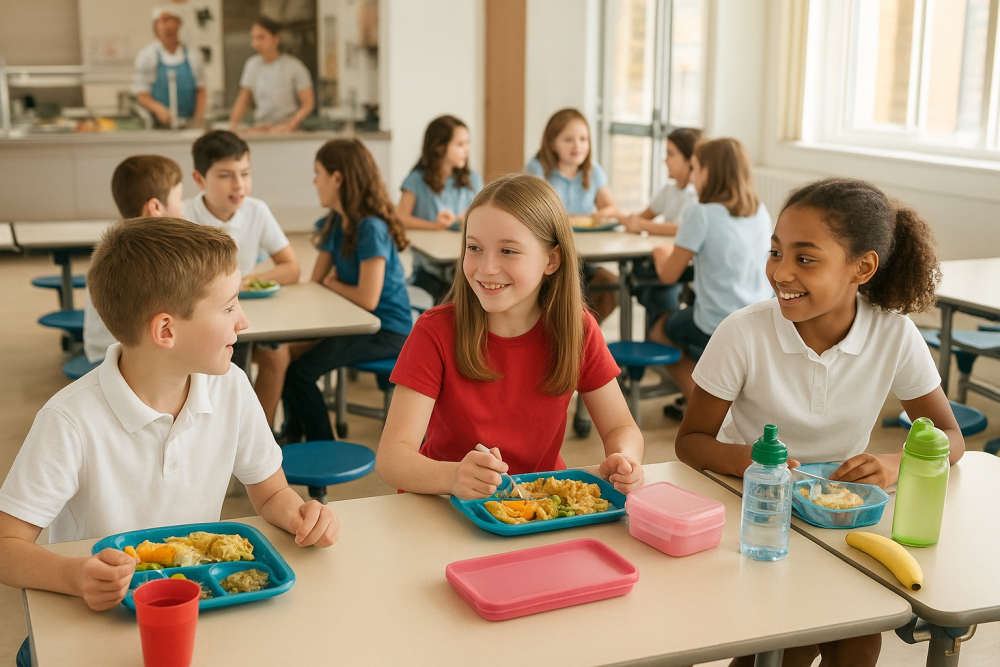
Choosing between school lunches and packed lunches isn’t as simple as it sounds. Every family – and every child – has different needs. Some children look forward to hot school meals, while others prefer the familiarity of food from home. The good news is that in many UK schools, you don’t actually have to choose one or the other. A mixed approach often works best.
The Primary School Approach
In most English primary schools, parents receive a weekly or fortnightly lunch menu. You can sign your child up for specific days depending on what’s on offer. Two of my private pupils, for instance, always have school lunch on Fridays (fish and chips day, of course!) but bring packed lunches on the other days. If there’s a particular favourite on the menu, their parents simply add an extra school meal for that day.
This flexibility makes life easier and ensures children get a good balance of nutrition and enjoyment. School meals are designed to meet government nutritional standards, offering a mix of protein, carbohydrates, and vegetables. For busy parents, that can be reassuring.
Packed lunches, meanwhile, give you full control over ingredients. This is ideal for fussy eaters or children with allergies. But packed lunches can vary hugely in quality. The classic sandwich-crisps-chocolate combo might fill a stomach, but it won’t necessarily fuel a full day of learning. Including fruit, whole grains, or something with protein makes a big difference to a child’s concentration and energy.
Secondary Schools: Independence and Choice
Secondary schools tend to run buffet-style canteens where students pick what they want from a range of options, each item priced separately. They pay using their school ID card, which deducts the amount from a pre-paid lunch account.
This setup gives teenagers independence but also means they’ll make their own decisions – for better or worse. Some will head straight for pasta or a jacket potato, while others might be tempted by chips or cookies most days. A quiet look at the online menu or balance history now and then can help parents see how things are going.
Weather, Seasons, and Social Time
Even the weather can influence the choice between packed lunch and school meals. In winter, a hot school meal can be comforting and warming – especially after outdoor play. But once spring or summer arrives, many children prefer the freedom of sitting outside with a packed lunch in the playground or on the grass.
Schools differ in how they handle this. Some have clear areas for packed-lunch pupils; others allow everyone to sit together. For certain children, that makes all the difference. Lunch isn’t only about food – it’s also about spending time with friends, and that social side can tip the balance one way or the other.
Cost, Convenience, and the Environment
Parents often ask which is more cost-effective: school dinners or packed lunches. School meals usually come at a set, subsidised price, which helps with budgeting. Packed lunches can seem cheaper at first, but shopping for fresh, healthy ingredients soon adds up.
There’s also the question of time and effort. For some families, the convenience of a ready-made school meal is worth the cost. Others prefer the control and routine of packing lunches at home.
From an environmental point of view, school kitchens prepare food in bulk, which often means less packaging waste. Packed lunches can create more, especially if everything is individually wrapped. Reusable containers, refillable bottles, and cloth napkins go a long way towards keeping things eco-friendly.
Allergies, Preferences, and Personalisation
Most schools now cater well for allergies and dietary restrictions, but it’s still important to keep communication open. If your child avoids certain ingredients, talk to the school office or kitchen early on.
Packed lunches allow for even more personalisation – you know exactly what’s inside, and you can include familiar family dishes or cultural favourites that remind your child of home. It’s also a great way to involve children in choosing and preparing their meals, giving them a sense of ownership and pride in what they eat.
Finding Your Balance
There’s no rule saying you have to pick one option and stick to it. Many families mix school lunches and packed lunches depending on the week’s menu, their schedule, or even the season. Some days, the convenience of a hot meal at school wins out; other times, a homemade lunch just feels right.
The aim isn’t perfection – it’s balance. As long as your child feels nourished, comfortable, and happy at lunchtime, you’re doing it right.

Thank you so much for this beautifully written and practical guide – I really enjoyed reading it. It sparked a question I’ve been sitting with: how does this apply in private school settings?
My son Andrew attends a private school, and we’ve recently been told by his teacher that he’s not regularly eating his lunch. Unfortunately, we’re not allowed to send packed lunches, which makes it harder to support him directly. I’d love to hear any thoughts or experiences from other families navigating similar situations – especially around how to gently advocate for a child’s needs when school policies feel limiting.
Thank you again for opening this conversation so thoughtfully.
Thank you for your kind words and for sharing your question. You’re right, private school lunch arrangements are a bit more difficult when there isn’t an option to send a packed lunch.
If the school publishes menus in advance, then that’s a good place to start. Sitting down with Andrew to look at what is going to be on the menu the following day can help him feel more prepared. It might be worth asking if he could choose one of the alternatives on those days. If he doesn’t like the main alternative either, suggest he just has a few ‘sides’ like a filled jacket potato and some steamed vegetables, which are generally available daily.
It may help to let his teacher know that you’ve talked this through with him, so that he can help him choose an alternative to the dish he doesn’t want to eat. To make it easy for the teacher, you could give a short note to the teacher on mornings when Andrew would prefer an alternative dish.
It’s completely understandable to want to advocate for him while respecting school policy. It is important that Andrew doesn’t get too hungry in the afternoon. Many children (and quite a few adults too!) become tired and irritable when they haven’t eaten enough. A nutritious meal at lunchtime can make a big difference to a child’s afternoon mood, energy levels and concentration.
Another consideration is the financial side. In private schools lunch costs are already included in the school fees, whether the child eats the lunch or not, so obviously nobody wants to pay for something that isn’t being used.
I really hope my suggestions will help, and Andrew will find things he likes to eat.
Thank you so much for your kind advice. I truly appreciate your suggestions – they are practical and thoughtful. I will try looking at the menu with Andrew and let his teacher know when he would prefer something else. It is reassuring to feel supported in making sure he is well-fed and comfortable at school.
I hope my suggestion will work. Andrew is too young to make these decisions by himself on the spur of the moment, but if you talk to him about the menu beforehand, he will arrive at school well prepared and both you and he can tell the teacher what he would prefer to eat each day. And hopefully he will then enjoy what he has chosen. It will at least give him the feeling that he has had a say in the matter. He may occasionally still not like what he has chosen and that will simply be part of the learning process. Simply put it down to experience, learn from it and move on.
Lots of good wished to you and Andrew.
Isabella